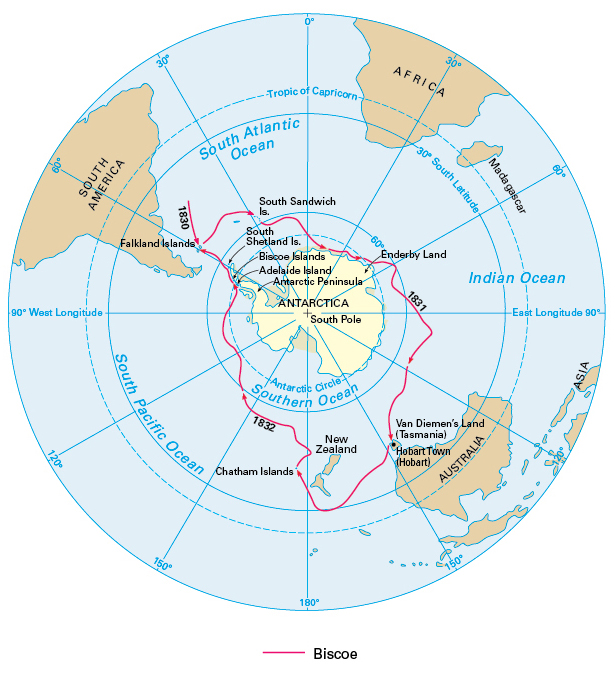Biscoe, John (1794-1843), was an English sea captain and explorer . He led the third expedition that circumnavigated (sailed completely around) Antarctica , after the British navigator James Cook and the Russian naval officer Fabian von Bellingshausen . Biscoe discovered and charted several areas of Antarctica. He helped show that Antarctica was a continent .
Biscoe was born in Enfield, Middlesex, England , around June 28, 1794. He served in the British Royal Navy during the War of 1812. In 1830, the Enderby brothers, London oil and fur merchants, hired Biscoe to lead an exploring and sealing voyage in southern waters. Biscoe left England in July 1830 with two ships—the Tula, which he captained, and the Lively. Sailing south, he reached the Falkland Islands in November. He continued southeast, visited the South Sandwich Islands in December, and crossed the Antarctic Circle in January 1831. He then traveled eastward around Antarctica. In February, Biscoe discovered an area of land that he named Enderby Land . A storm then separated the ships, and many crew members became ill with scurvy . The ships regrouped several months later in Hobart Town , Van Diemen’s Land (now Hobart, Tasmania , Australia ).

The expedition set out again from Hobart Town in October 1831. It sailed east and north around New Zealand, stopping at the Chatham Islands to hunt seals, then continued east and south around Antarctica. In February 1832, Biscoe discovered several islands west of the Antarctic Peninsula—Adelaide Island, which he named for British Queen Adelaide, and what are now the Biscoe Islands. Farther north, he landed and claimed the area for the United Kingdom . He thought he had reached the mainland, but it was more likely Anvers Island. He named the area Graham Land. Biscoe continued on to the South Shetland Islands, then the Falklands, where the Lively was wrecked. After most of Biscoe’s crew deserted, he was forced to return home. The Tula reached England in early 1833.
The expedition was geographically significant but not commercially successful. Biscoe received the Royal Geographical Society’s Gold Medal for his discoveries. In 1837, he moved to Australia. By then he was ill and lived in poverty. He died at sea in 1843 while returning to England.
